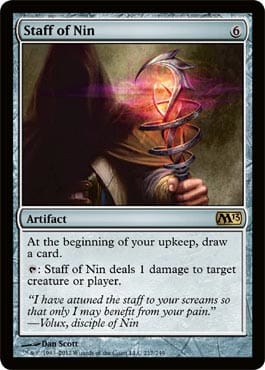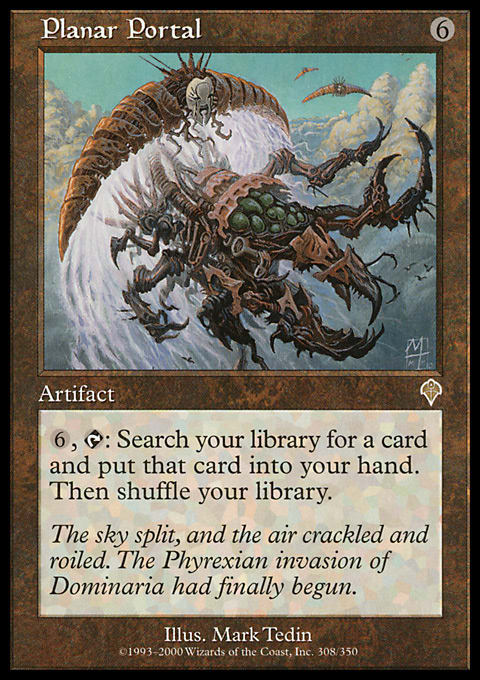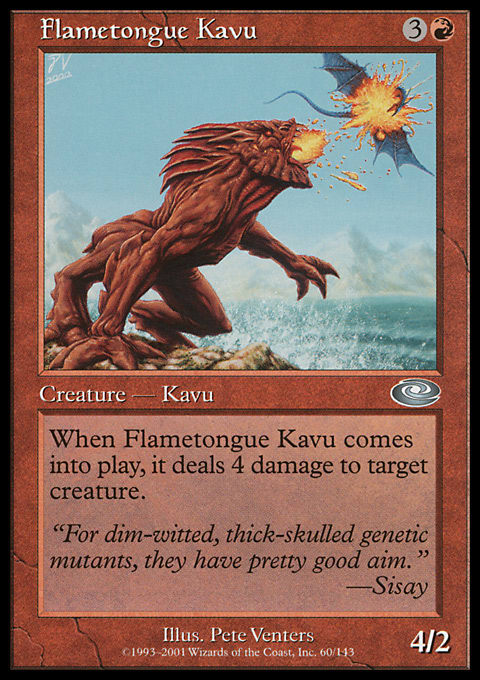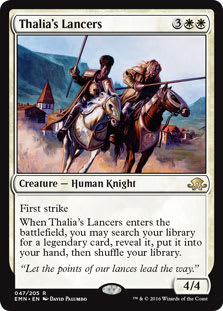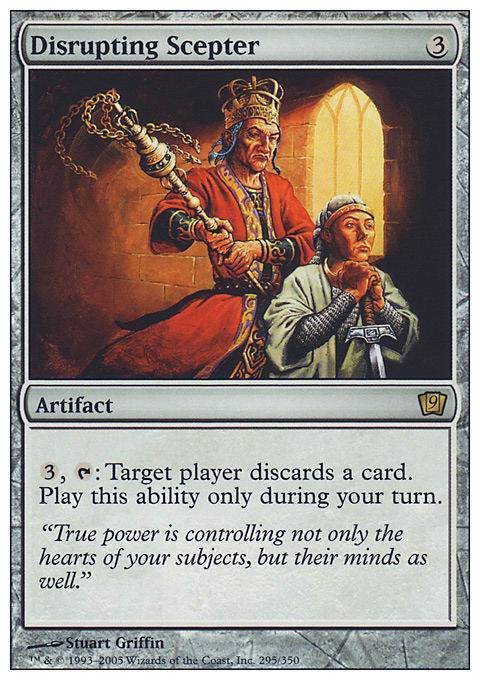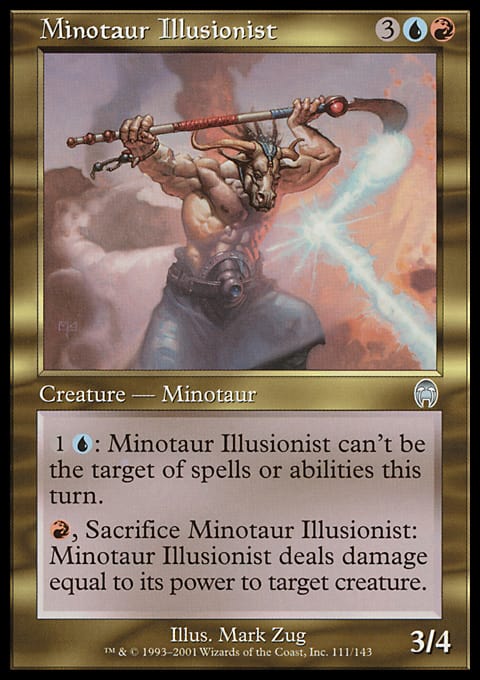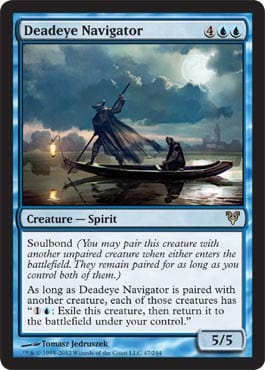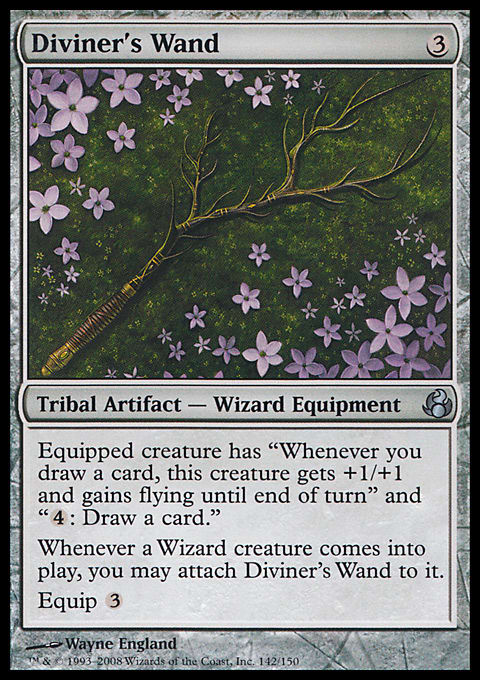Hello folks! Multiplayer strategy is odd and can be hard to figure out at times. Often the smart play at a duel is the wrong one when dialing it up against multiple players. Cards run totally different card quality. A card like Duress can be great in duels and horrible in multiplayer. In a duel, card advantage is already a key concept, while in multiplayer it’s downright essential. Learning how things are differently manifested in multiplayer is important to your success there.
And one of those is learning about how different permanents have different levels of power. Both for that format, as well as generally in multiplayer.
Every multiplayer game uses cards of different power levels. Every metagame and playgroup is different, and some places have cards that are killed on arrival more quickly than others. That’s the nature of the beast.
But we know that all cards are not created equally. There is a real difference between Jayemdae Tome, Staff of Nin, and Mind's Eye. There’s a major power level of difference between Rofellos, Llanowar Emissary’s ability to speed your mana versus Selvala, Heart of the Wilds. Permanents have different levels of threat, different levels of solution, and differing levels of power than come with it.
They also send different signals. Everybody laughs when I play Scarwood Bandits. But if you are playing a bunch of critical artifacts, you may kill it quickly, despite the seriously elevated jank levels of the Bandits.
Cards have two major qualities in assessing their power. The first is their actual power, and then the second is their perceived power. Then each card has a Heat Index that fluctuates with the intersections of these two factors. Ideally, you want to run cards with a low, or sub-zero heat index. A card that appears to be weaker than it plays would have a -1 or -2 negative Heat Index. On the other hand, a card perceived to be more powerful than it actually is would have a positive Heat Index, and thus would be something you would generally want to stay clear of running.
Let me give you two hypothetical examples just to illustrate this point. (We’ll look at the math later). Consider the artifact Staff of Nin. It’s a 6-drop with a certain actual power rating. Now imagine that your table always destroys, counters, or otherwise deals with Staff of Nin sharply. In real life, its power level may be just a 6 (check out the numbers below for example), but your table is killing it like an 8 or 9. So at the table, it has a heat index of +2 or +3, and you aren’t getting value from your card like you should. Why bother running it?
An example of the opposite might be Planar Portal, another six-mana rare artifact. In reality, it’s probably a 6 in power. But your table and playgroup may not care. After all, the first time you use it is twelve mana for a Demonic Tutor! I can just run the DT instead. So if your playgroups lets you runs and use it multiple times, then at your table, the Portal could have a -2 Heat Index. That’s what you are looking for, because you got away with playing a card of higher quality.
Ultimately, the goal of this article is to help you find the good stuff as well as to better identify threats and problems on the multilayer table. And, for tomorrow’s Top Ten article, I’ll be looking at ten cards that are flying under the radar now at Commander and multiplayer games, and aren’t getting the attention they deserve.
So how does this concept work in reality?
Understanding the Heat Index
Assessing the Heat Index of a Card:
Every permanent played at the kitchen table is a threat. It has a level of power attached to it. From a lowly Swamp to a powerful Ugin, the Spirit Dragon, if it’s a permanent, it has a threat level. There is a Heat Index to it.
But we know that a card like Steel Wall will be on a different level of problem than an uber-blocker like Fog Bank. We see a card such as Disrupting Scepter on a different level than a card like Liliana's Specter or Birds of Paradise. Understanding how those cards’ Heat Index works is important to unlocking the ability to play cards that outpunch their reputation.
Let’s take a look at the first of these intersections.
Actual Power Level — The first is the Actual Power Level of the card in question. How powerful is it really? Not every Magic card is created evenly. Ever since the first set gave us Gray Ogre (a vanilla 2/2 for 3 mana), Uthden Troll (regeneration 2/2 for the same mana) and Granite Gargoyle (flying and inflatable toughness for the same mana) we’ve seen different power levels. Clearly the Actual Power Level of a Granite Gargoyle is considerably higher than that of a Gray Ogre.
The only thing that matters for Actual Power Level (APL) of a permanent is once it’s in play. A triggered ability that no longer does anything doesn’t matter for stressing its APL. Take Merchant of Secrets. On the battlefield, it’s weaker than Tundra Wolves. So the APL assessment of Merchant is worse than Tundra Wolves, even though the Merchant’s enters-the-battlefield (ETB) trigger makes it replace itself, so it has a level of play value for your deck in excess of its APL. However, note the pressure of the trigger does give the card a little more power to it when not in use. People tend to be more aggressive with a Flametongue Kavu than a Giant Cockroach, because it’s already killed something, or it can be blinked, and so forth. So you won’t find a 2/1 Eternal Witness ranked alongside Gray Ogre on the lowest level, but it would be just one higher than normal for its stats.
And that continues in other aspects of the permanent in question as well. No Magic card is played in a vacuum. They are played with each other. Note that a card has a given APL that can change as the game progresses. And the synergy of cards together increases the current Actual Power Level of a card as the board state shifts. Take a card like Goblin Piledriver. By itself it’s just a 1/2 pro Blue 2-drop. That’s certainly nothing special. But on a board with a pair of Goblin friends, it’s now a 5/4 attacking engine of death — with a much higher Actual Power Level as a result.
The same is true for cards with an altered board state. A card like Serra Ascendant that’s becoming a 6/6 flyer for one mana is one thing. When it’s not super amped up, it’s pretty minor. Cards like threshold and such have different Power Levels based on their current state as well.
So I want to create a scale whereby we can differentiate the Actual Power Level of cards. Now remember, this is an article on multiplayer theory, not on how to win Standard or Vintage. So we are looking at the Actual Power Level of cards in multiplayer, not in duels.
I have created a ten point system, with a few examples of cards at each level of Actual Power, to demonstrate where cards fall:
Multiplayer Actual Power Level Rankings:
1: (Total Chaff) Gray Ogre, Chimney Imp, and many others.
2: (Weak, But With Some Value) Steel Wall, Flametongue Kavu, Craw Wurm, Tibalt, the Fiend-Blooded, Grizzled Leotau.
3: (Lighter, Has Value in Right Home) Thorn of the Black Rose, Mask of Avacyn, Thundermare, Guardian Idol, Minotaur Illusionist, Sakura-Tribe Elder.
4: (Useful Tools, Adequate Threats) Ophidian, Bonesplitter, Gorgon Flail, Icy Manipulator.
5: (Good Utility, Okay Threats) Acidic Slime, Shivan Dragon, Serra Angel, Shadowmage Infiltrator, Chandra Nalaar, Diviner's Wand, Guardian Beast, Commander Eesha, Kamahl, Pit Fighter, Fervor, Fog Bank, Inspiring Statuary.
6: (Strong, Reliable Stuff )Harvester of Souls, Ajani Goldmane, Xenagos, the Reveler, Bonehoard, Soul Warden.
7: (Need Assistance to Break Games or Strong Quality) Umezawa's Jitte, Nim Deathmantle, Mother of Runes, Mirari's Wake, Sensei's Divining Top, Kor Haven, Maze of Ith, Jace, Unraveler of Secrets, Wild Pair.
8: (Top Shelf Quality) Lightning Greaves, Mindslaver, Palace Siege, Sword of Light and Shadow, Rhystic Study, Oblivion Stone, Darksteel Colossus, Akroma, Angel of Wrath, Future Sight, Moat, Karn Liberated, Iridescent Angel, Doubling Season, Privileged Position, No Mercy, Vedalken Orrery, Stuffy Doll.
9: (Game-Winners and Strong Bombs), Teferi, Mage of Zhalfir, Liliana Vess, Grave Pact, Blightsteel Colossus.
10: (Total Powerhouses) Consecrated Sphinx, Volrath's Stronghold, Avacyn, Angel of Hope, Pernicious Deed, Yawgmoth's Bargain.
Now there are tons more cards in print the worse on the list you go. I could add in vanilla stuff, limited only cards, and more and just loaded down the lower half of the list. We also have a ton of solid entries in the 4-6 area as well.
Remember that cards which already triggered, like Elvish Visionary, Thalia's Lancers, Eternal Witness, or Flametongue Kavu have a different Actual Power Level once they are on the table. Nekrataal is just a 2/1 first strike once it arrives, and it’s not really getting a lot of looks.
The goal of any deck-building is to find the good 7+ level stuff that often defines the board and pushes folks around. 7s are game winners with the right party favors, or just really strong with friends. You see cards there like high quality equipment, the Mother of Runes, etc. 8s are cards that push the board around in major way and may need a pal or two but which win from there (like Doubling Season) when they do and are otherwise top shelf quality like Akroma, Angel of Wrath. 9s are true bombs and powers, with the one-hit kill of Blightsteel Colossus, or Grave Pact as true forces. 10s are the best of the best. There are only a handful of true 9s and 10s. Most top multiplayer cards are in the 7-8 range.
(Now I give you this list with a few caveats. Clones and such can’t be rated. And obviously, this reflects my own assessment of the Actual Power Level of these cards over long amounts of play. I only included cards I’ve played heavily. But I admit I could have misidentified a card that’s really a 5 as a 6 or as a 4 or something).
Cards that are 2 have little impact on the game, but can be useful in the right place. I have extolled the virtues of Steel Wall for a long time, and still do in the right shell, but it’s not any higher than a 2 in Actual Power. 3s have limited use, but useful utility permanents like Seal of Doom can put in some good work at this level. 4s are good tools and adequate creatures and defenders. Meanwhile your 5s are good mechanics, reliable creatures, strong utility and such. 6s are solid cards with a good board presence.
And remember, this is the Power Rating once they are on the board. Take a card like Bojuka Bog. It’s done its thing. It’s not a major threat. A card with a sacrifice trigger like Sakura-Tribe Elder is a little different, since you can play games like block and sacrifice or such. It has a higher Actual Power Level on the battlefield.
But the Actual Power Level of a card is not the sole determinant of what to kill, or what to do. You may want to turn Path to Exile on a ETB creature to prevent it from coming back over and over again and end any shenanigans. So there are times when you are going to answer something with a low on-the-table power level more quickly than otherwise might be expected.
Perceived Power Rating — A card’s Perceived Power Rating is how the people around the board actually see it. In fact, each player sees it differently from others. Just like the Actual Power Level can shift as the board state changes, the Perceived Power Rating can as well. However, this is more fluid than the APL.
Why?
Well each permanent impacts people differently. Take Disrupting Scepter. Let’s say it has an Actual Power Level of 4. But one player has no cards in their hand, then they may assess it with a Perceived Power Rating of 2. Meanwhile that control deck with a stocked grip has a 6 on their PPR index. The control player may even be so threatened that they Forbid it, when others aren’t bothered by it at all.
This is true for lots of factors. What’s the battlefield state? Someone with few non-land permanents may give a lower PPR to a Nevinyrral's Disk. And this even applies to hidden knowledge. If I’m playing Blue and I know that my deck doesn’t have any answers to a certain card type you just played, then my PPR may be higher, just based on my deck.
One of the keys to unlocking the difference between Actual and Perceived levels of power is understanding different factors that cause it.
Why are some cards perceived as higher or lower than their Actual Power Level? Good question! There are a variety of reasons for it. Let’s take a look:
- Reputation in other Formats. The actual power level of Jace, the Mind Sculptor is a 6 in multiplayer. In duels, it’s a 10. Due to that reputation, it’s often improperly assessed in a multiplayer context. This is true of cards like Tarmogoyf, Baneslayer Angel, and other big hits from duel and formats.
- Reputation in this Format — As a sidenote, there are cards that have a bad reputation in the format you are playing them. Take Commander, for example. Deadeye Navigator is a commonly played card, and I’d assess its Actual Power Level at 7. But due to the massive abuse and reputation it has at other Commander tables, it’s PPR is more like 9. It’s not really that strong, but that’s how the perception in the format is. So in that format, it usually has a +2 Heat Index.
- Deathtouch and Keep-Away. Creatures with deathtouch are often seen as more powerful than they actually are. Take Thorn of the Black Rose, an expensive 1/3 deathtouch Assassin that replaces itself. It’s not like a 1/3 is major threat, but people will avoid attacking into it for fear of “trading down.” Even a simple Typhoid Rats can hold back stuff and is treated as better. This is also true of cards like Aura Thief and others that have cool death triggers — they are seen as more powerful than they are. I’ve even seen Goliath Sphinx do amazing work because no one wants to trade with a French Vanilla creature. (I have also used Loyal Sentry to good effect for this reason).
- Takes a Lot of Resources. I’ve written an entire article about why Treasure Trove is seen as worse than it actually is. Sure it takes four mana per iteration, but it doesn’t tap and provides a useful source of card advantage. People regularly don’t appreciate its power. (I’ve seen the same thing with Diviner's Wand as well)
- It’s Subtle. Frankly speaking, a ton of cards aren’t respected because they are subtle. Icy Manipulator is a prime example. It’s actually not that bad at all. Tap a Maze of Ith before combat. Tap a blocker. Tap a Command Tower to lock off your opponent from playing their Commander’s third color and dropping it this turn. Tap a Blue producing land to keep them from Counterspell’ing your stuff. Tap a key artifact. Tap a creature to keep it from the swinging. You get the idea. It’s got some chops, but it’s disrespected, and has a lowered Perceived Power Rating as a result. Another subtle card is Ophidian. It’s not hitting people for damage, it’s not causing a ruckus. And you are drawing the occasional card to it. These cards are often more powerful than a lot of people realize.
- Obscureor New — Another reason for the difference in rankings is due to cards people haven’t played a lot. This often happens both with newer cards that people haven’t played with yet or when you rock that obscure card that folks didn’t know existed, such as Baton of Morale. (That’s one reason why my Commander decklists after the release of a new set for you often feature recently released stuff and really old and obscure stuff as well.)
- The Metagame Shifted — There are cards that recently saw a metagame shift. When someone just showed how good a card like Sword of the Animist can be, then it could be perceived more highly than the APL. This is also true for combo elements after combo burned your table. A card like Goblin Bombardment that might usually fly under the radar gets targeted early as its Heat Index has risen. Understanding these shifts in metagame heat can help you find cards that have been given a yellow card, and need to be avoided for a while.
- It Helps Me — A lot of people like running cards that help the table because they often fly under the radar. Take a card like Pandemonium or Fecundity. Both give you the ability to get triggers and deal damage or draw cards. Everybody can use them! Because you can use it too, there is a temptation to leave it alone for now. Other than all-draw stuff like Howling Mine or a few other cards, this stuff is usually run to help one player more than another. Just like a Wrath of God is played when you have few creatures, a Mana Flare is used when you have a lot of expensive and X stuff to play or a Fecundity in a deck that’s loaded with self-sacrificing. But these cards regularly have a lowered PPR.
I’m sure there are other random reasons for stuff getting higher or lower PPR from the APL. It happens.
Oh, and by the way, I intentionally layered in cards that I think are under-appreciated at the kitchen table into that Actual; Power list (like Minotaur Illusionist). They’re better than they are perceived to be, and have a higher APL than a lot of folks think. I included them for comparison and consideration.
Okay, so now that you know a card’s APL and PPR, you can figure out the Heat Index:
Subtract the APL from the PPR(typically at your table) of a card. The result is the card’s Heat Index.
This cross section of a card’s Actual vs Perceived power is where you want to hone in. Cards with identical ratings across the board play as they feel. It’s important to understand that most cards have a Heat Index of zero. Their Actual and Perceived powers line up. The latest recently spoiled card from Amonkhet is a useful example. Take, say, Hyena Pack. It’s a vanilla 3/4 for 4 mana. It’s Actual and Perceived ratings are both 2. And you can similarly assess the new cards of Amonkhet that get released. There will likely only be 20-30 cards each set that begin with a Heat Index out of alignment because people make wrong assumptions or don’t know how to play them yet. Kaladesh was different because you had both energy and vehicles to figure out, and to a lesser degree Aether Revolt, so those both had a higher percentage of confusing cards we had to figure out with practice.
As I said, most cards are going to have a Heat Index of zero. Consecrated Sphinx is a 10 on both charts. It will always be a 10. It’s never going to be seen as anything different.
Some cards are going to have a positive number. These cards have a Heat Index that suggests they will be taken out in excess of its real impact of the board. Take Deadeye Navigator. I think it probably has a Heat Index of +2. Unless you have a deck that pushes it to the 9 or 10 APL due to synergy, it’s better to not play it, so it won’t get smashed. Run a 7 APL card with a Heat Index of 0, that won’t draw as much ire and hate.
The final group of cards has a Heat Index in a negative amount. These are seen or treated as lesser threats than they typically play. They are underappreciated. Take a card like Hammer of Purphoros. I’d rate it as a 5 APL, but it’s not really getting respect right now. (Neither are the other all-haste stuff). It probably has a Heat Index of -1. So do cards like Diviner's Wand. Due to a lack of play, I think Baton of Morale is -3 right now. Ophidian is -1 or -2 in some groups. Avenging Druid is -2 in places that don’t run it, and 0 in others.
I’ve found some Planeswalkers are getting odd levels of heat recently. Major tournament forces are at + heat, and major casual forces that are heavily used, like Nicol Bolas, Planeswalker or Ugin, the Spirit Dragon are at the right level. But some classic multiplayer stuff is flying at a negative Heat Index, like Ajani Goldmane, Garruk Wildspeaker, and many of the Chandras. I think the lowest right now is stuff like Domri Rade, Sarkhan Vol, or Ral Zarek, which I’d rate as a clear -2. I think even both Kioras are at -1.
Understanding the Heat Index is a key to understanding what will stick at your kitchen table at your next Multiplayer Monday. After all, it doesn’t matter how good your card was if it’s dead. An on the battlefield Diviner's Wand that has drawn a few cards outclasses that Mind's Eye that was Dissipate-d long ago.
A lot of players sort of understand this concept intuitively. But getting this crystallization, with the numbers, and rankings, and the interactions between actual and perceived levels of power is important to really grokking what the Heat Index is.
Today we looked at the Actual Power Level of permanents when shuffling it up against a few players. Then we drilled into the Perceived Power Rating of cards, and discussed reasons for it. Finally, we looked at how the difference in these two can create a perception vs reality disconnect that you can tap into.
Tomorrow I want to push this theme. We’ll count down the Top Ten Cards You Should Auto-kill On Sight (But Don’t). They have a negative Heat Index but are too powerful for that crap. (At least one or two cards on that list was mentioned here today, by the by . . . )
Anyways, I hope you got something out of today’s article. What cards have an elevated Heat Index ion your playgroup?













